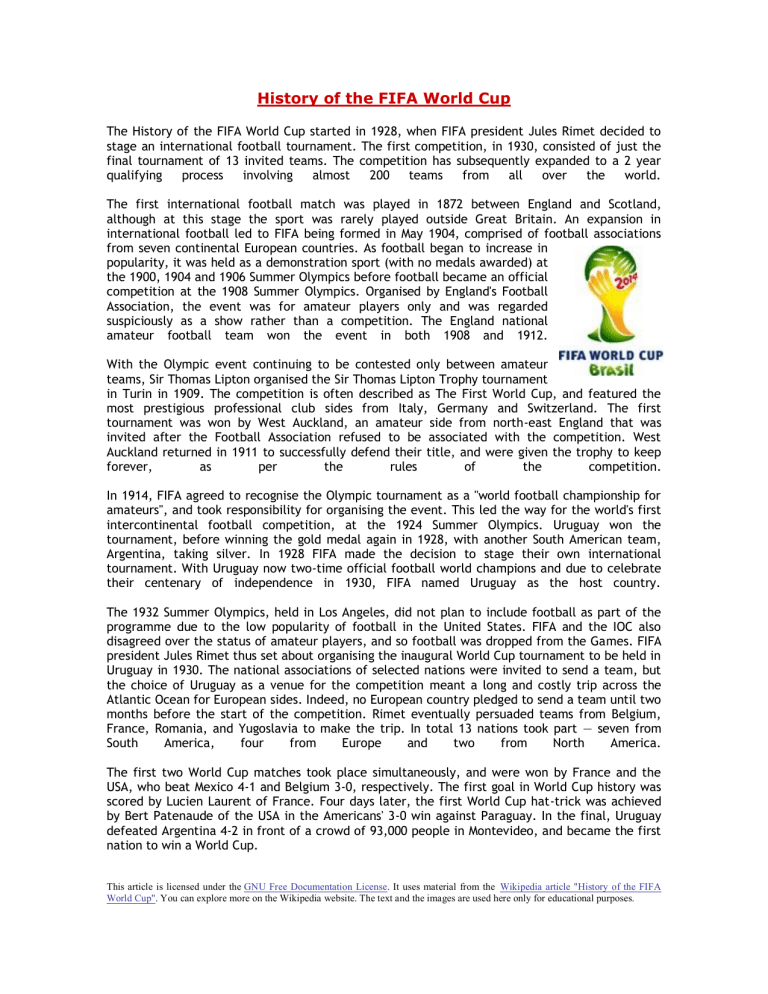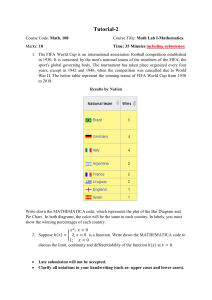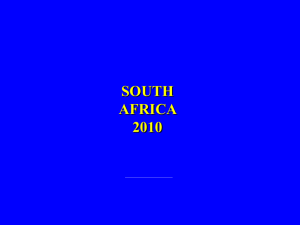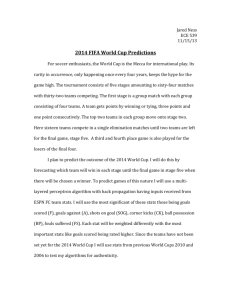
History of the FIFA World Cup The History of the FIFA World Cup started in 1928, when FIFA president Jules Rimet decided to stage an international football tournament. The first competition, in 1930, consisted of just the final tournament of 13 invited teams. The competition has subsequently expanded to a 2 year qualifying process involving almost 200 teams from all over the world. The first international football match was played in 1872 between England and Scotland, although at this stage the sport was rarely played outside Great Britain. An expansion in international football led to FIFA being formed in May 1904, comprised of football associations from seven continental European countries. As football began to increase in popularity, it was held as a demonstration sport (with no medals awarded) at the 1900, 1904 and 1906 Summer Olympics before football became an official competition at the 1908 Summer Olympics. Organised by England's Football Association, the event was for amateur players only and was regarded suspiciously as a show rather than a competition. The England national amateur football team won the event in both 1908 and 1912. With the Olympic event continuing to be contested only between amateur teams, Sir Thomas Lipton organised the Sir Thomas Lipton Trophy tournament in Turin in 1909. The competition is often described as The First World Cup, and featured the most prestigious professional club sides from Italy, Germany and Switzerland. The first tournament was won by West Auckland, an amateur side from north-east England that was invited after the Football Association refused to be associated with the competition. West Auckland returned in 1911 to successfully defend their title, and were given the trophy to keep forever, as per the rules of the competition. In 1914, FIFA agreed to recognise the Olympic tournament as a "world football championship for amateurs", and took responsibility for organising the event. This led the way for the world's first intercontinental football competition, at the 1924 Summer Olympics. Uruguay won the tournament, before winning the gold medal again in 1928, with another South American team, Argentina, taking silver. In 1928 FIFA made the decision to stage their own international tournament. With Uruguay now two-time official football world champions and due to celebrate their centenary of independence in 1930, FIFA named Uruguay as the host country. The 1932 Summer Olympics, held in Los Angeles, did not plan to include football as part of the programme due to the low popularity of football in the United States. FIFA and the IOC also disagreed over the status of amateur players, and so football was dropped from the Games. FIFA president Jules Rimet thus set about organising the inaugural World Cup tournament to be held in Uruguay in 1930. The national associations of selected nations were invited to send a team, but the choice of Uruguay as a venue for the competition meant a long and costly trip across the Atlantic Ocean for European sides. Indeed, no European country pledged to send a team until two months before the start of the competition. Rimet eventually persuaded teams from Belgium, France, Romania, and Yugoslavia to make the trip. In total 13 nations took part — seven from South America, four from Europe and two from North America. The first two World Cup matches took place simultaneously, and were won by France and the USA, who beat Mexico 4-1 and Belgium 3-0, respectively. The first goal in World Cup history was scored by Lucien Laurent of France. Four days later, the first World Cup hat-trick was achieved by Bert Patenaude of the USA in the Americans' 3-0 win against Paraguay. In the final, Uruguay defeated Argentina 4-2 in front of a crowd of 93,000 people in Montevideo, and became the first nation to win a World Cup. This article is licensed under the GNU Free Documentation License. It uses material from the Wikipedia article "History of the FIFA World Cup". You can explore more on the Wikipedia website. The text and the images are used here only for educational purposes.


